Indian Polity: December 2024 UPSC Current Affairs | Indian Polity for UPSC CSE PDF Download
Bharatiya Vayuyan Vidheyak 2024: Features, Criticisms, and Implications for India’s Aviation Sector
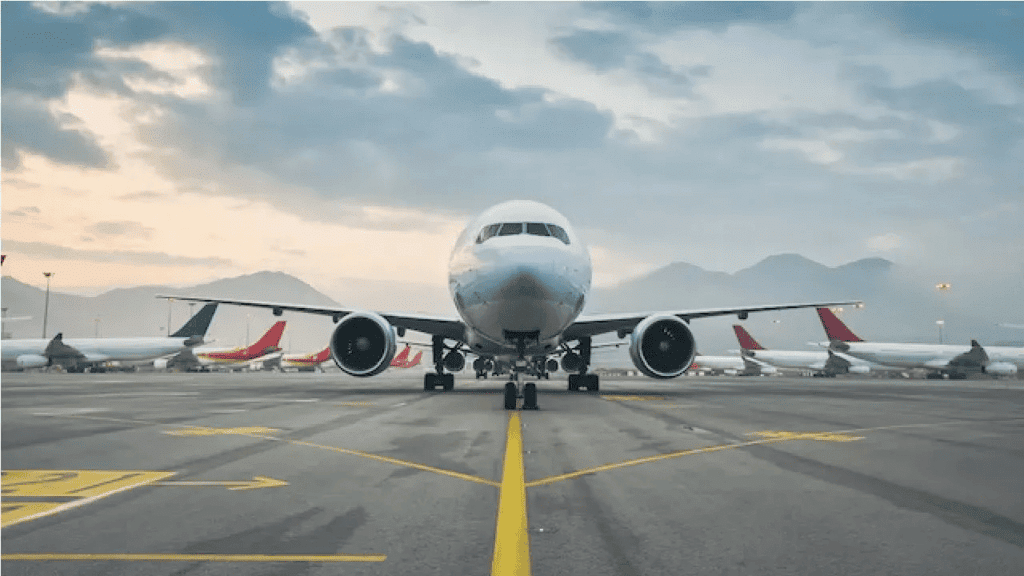
Why in News?
The Bharatiya Vayuyan Vidheyak 2024, which replaces the Aircraft Act of 1934, represents a significant reform of India's aviation laws. Approved by the Rajya Sabha after passing through the Lok Sabha in August 2024, this legislation aims to improve the ease of doing business within the aviation sector. The outdated Aircraft Act had been amended 21 times and now gives way to modern provisions that address contemporary challenges and opportunities in aviation.
Key Takeaways
- The new legislation establishes three crucial regulatory authorities: the Directorate General of Civil Aviation (DGCA), Bureau of Civil Aviation Security (BCAS), and Aircraft Accidents Investigation Bureau (AAIB).
- It introduces stricter penalties for aviation-related offences, enhancing the regulatory framework for safety and compliance.
Additional Details
- Establishment of Authorities:The Bill sets up three authorities:
- DGCA: Responsible for regulatory functions and safety oversight.
- BCAS: Handles security oversight.
- AAIB: Conducts investigations into aircraft accidents.
- Government Supervision: The central government maintains overall control over these authorities, with the power to issue directions and review their orders.
- Regulatory Enhancements: The Bill retains existing provisions for aircraft design, manufacturing, and operation while introducing new powers related to aircraft design and radio communication regulations.
- Stricter Penalties: Violations of aviation safety rules can result in severe penalties, including imprisonment and hefty fines.
- Concerns Raised: Key criticisms include the limited autonomy of the DGCA, restricted appeal options to the Union Government, potential violations of constitutional equality, and the exclusionary nature of the Bill's Hindi title.
- The Bharatiya Vayuyan Vidheyak 2024 is a landmark legislation that aims to modernize India's aviation framework, though it raises significant concerns regarding regulatory independence and inclusivity. The implications of this Bill will need to be closely monitored to ensure that it meets the needs of a diverse population while enhancing the safety and efficiency of the aviation sector.
PMAY-U 2.0

Why in News?
The Union Cabinet has recently approved the PMAY-U 2.0 initiative, which aims to provide essential financial support to urban poor and middle-class families. This scheme will facilitate the construction, purchase, or renting of houses at affordable costs for up to one crore families.
Key Takeaways
- PMAY-U stands for Pradhan Mantri Awas Yojana (Urban).
- It is administered by the Ministry of Housing and Urban Affairs.
- The primary goal is to ensure the availability of all-weather pucca houses to eligible beneficiaries in urban areas.
- So far, 1.18 crore houses have been sanctioned under this initiative, with over 85.5 lakh houses already constructed and delivered.
Additional Details
- Eligibility Criteria: Families belonging to the Economically Weaker Section (EWS), Low-Income Group (LIG), and Middle-Income Group must not own any 'pucca' house anywhere in the country to qualify for assistance.
- Coverage Area: The scheme encompasses all statutory towns as per the Census 2011, including subsequently notified towns and regions under various Urban Development Authorities.
- Financial Assistance: States and Union Territories will provide financial aid to urban poor over the next five years, with a government subsidy of ₹2.30 lakh crore, contributing to a total investment of ₹10 lakh crore.
- Credit Risk Guarantee Fund: The corpus of the Credit Risk Guarantee Fund Trust has increased from ₹1,000 crore to ₹3,000 crore to enhance affordable housing initiatives under PMAY-U.
- This fund aims to benefit the EWS and LIG segments by offering credit risk guarantees on affordable housing loans.
- The management of the Credit Risk Guarantee Fund will be transitioned from the National Housing Bank to the National Credit Guarantee Company.
- The PMAY-U 2.0 initiative represents a significant step towards improving housing access for low-income families in urban areas, enhancing homeownership rates and contributing to the overall development of affordable housing in the country.
Demand for Holding Parliament Sessions Outside Delhi
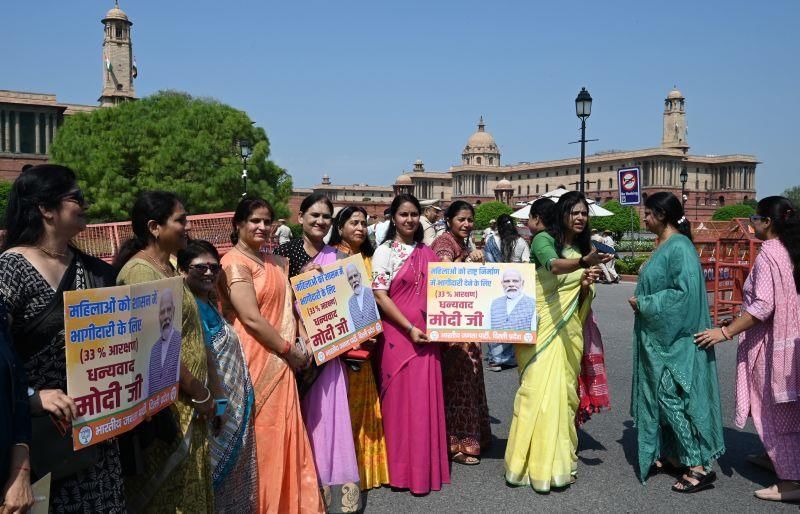
Why in News?
Recently, a Member of Parliament (MP) from the YSR Congress proposed the idea of conducting two Parliament sessions annually in South India. This proposal aims to address the logistical and climatic challenges that MPs encounter during the harsh winters and scorching summers in Delhi. Historical advocates for such decentralization, including B.R. Ambedkar and Atal Bihari Vajpayee, lend context to this renewed discussion.
Key Takeaways
- The proposal highlights the need for addressing climate issues faced by MPs in Delhi.
- It seeks to enhance regional representation by conducting sessions in southern states.
- Historical figures have previously supported holding sessions outside of Delhi.
Additional Details
- Historical Support: Dr. B.R. Ambedkar, in his book Thoughts on Linguistic States, advocated for a second capital in Hyderabad to address the cold and distance issues faced by southern populations. He emphasized that Delhi's geographical vulnerabilities posed a defense concern.
- In November 1959, Independent MP Prakash Vir Shastri introduced a resolution for holding Lok Sabha sessions in South India, specifically suggesting Hyderabad or Bangalore, which was supported by other MPs as a means to strengthen national unity.
Arguments for Holding Sessions Outside Delhi
- Enhanced Regional Representation: Sessions held in South India could improve visibility and representation of southern states in national policymaking.
- Climate Considerations: More favorable weather could enhance the health and productivity of MPs, leading to improved legislative efficiency.
- Decentralization of Power: This initiative aligns with the democratic principle that governance should be accessible to all citizens, enhancing the sense of inclusivity.
- Historical Precedent: Support from historical figures for similar proposals adds credibility to the current initiative.
Challenges to Consider
- Logistical Hurdles: The process of relocating parliamentary machinery and personnel presents a complex challenge that critics deem tedious and resource-intensive.
- Political Polarization: Critics warn that this move could exacerbate the North-South divide and reinforce regional identities over national unity.
- Institutional History: The 75-year history of Parliament operating from Delhi raises questions about the necessity of such a change, with critics suggesting that existing mechanisms suffice for regional representation.
Way Forward
- Pilot Regional Sessions: Conducting occasional parliamentary committee meetings or winter sessions in southern cities like Bengaluru or Hyderabad could help assess logistical challenges and public response.
- Strengthening Regional Representation: Increasing parliamentary seats for southern states after the census could address underrepresentation without the need for logistical disruptions.
- Enhancing Accessibility: Investments in communication technology and streamlined logistics could ease integration for MPs from all regions, mitigating travel and climate challenges.
- The proposal to hold parliamentary sessions in South India highlights ongoing debates regarding regional representation and political decentralization. While it raises valid concerns about inclusivity and climate challenges, the feasibility of this proposal remains contested.
- A balanced approach that strengthens existing systems, utilizes technology, and conducts regional pilot sessions could effectively address these issues, paving the way for a more inclusive and resilient governance structure in India.
Truckers Strike: Home Ministry Seeks to Pacify Truckers Protesting New Hit and Run Law

Why in News?
Transporters in India are currently protesting against the Bharatiya Nyaya Sanhita (BNS), which proposes severe penalties for drivers involved in hit-and-run accidents, including potential imprisonment of up to 10 years. This issue has sparked nationwide strikes from January 1 to January 30, reflecting the widespread concern among truck, bus, and taxi unions.
Key Takeaways
- Transporters are opposing Section 106 of the BNS, which increases penalties for hit-and-run cases.
- The Supreme Court has endorsed strict actions against reckless driving leading to fatalities.
- Current law under Section 304A of the IPC imposes a maximum of 2 years imprisonment for causing death by negligence.
- Concerns have been raised about the clarity and potential misuse of the new provisions.
Additional Details
- New Hit and Run Law: Under the BNS, penalties for negligent driving leading to serious accidents can reach up to 10 years of imprisonment and a fine of Rs 7 lakh. Drivers reporting accidents immediately are exempt from the harsher penalties.
- Road Safety Statistics: In 2022, India witnessed 4,61,312 road accidents, resulting in 1,68,491 deaths. A significant portion of fatalities occurred on National Highways, emphasizing the urgent need for improved road safety measures.
- Causes of Accidents: The main contributors include human errors, such as traffic rule violations, poor road conditions, and distracted driving. Over-speeding was responsible for a staggering 72.3% of all road accidents in 2022.
- Government Initiatives: Various measures have been implemented to address road safety, including engineering audits of roads, improved driving training programs, and enhanced penalties for traffic violations.
- The growing concerns regarding road safety and the new hit-and-run law highlight the need for a balanced approach that ensures accountability while safeguarding the rights of drivers. The ongoing protests reflect the critical dialogue needed to shape effective road safety legislation in India.
National Mission on Cultural Mapping (NMCM) and Monuments of National Importance

Why in News?
Recently, the Ministry of Culture highlighted the progress made under the National Mission on Cultural Mapping (NMCM) and India’s efforts to protect Monuments of National Importance (MNI). These initiatives aim to document the country's rich cultural heritage, revitalize rural economies, and ensure the preservation of historical sites for future generations.
Key Takeaways
- The NMCM was launched in 2017 to document and promote India's cultural heritage.
- It includes a portal named Mera Gaon Meri Dharohar (MGMD) that documents the cultural heritage of 6.5 lakh villages.
- Currently, there are 3697 ancient monuments and archaeological sites declared as of national importance in India.
Additional Details
- National Mission on Cultural Mapping (NMCM):This initiative aims to create a comprehensive database of cultural assets, artists, and art forms to enhance cultural vibrancy. Key objectives include:
- Defining and documenting unique cultural characteristics of each village.
- Launching cultural awareness programs like “Hamari Sanskriti Hamari Pahchan” (Our Culture, Our Identity).
- Utilizing cultural mapping to empower rural communities and boost economic development.
- Establishing a National Cultural Working Place (NCWP) portal for sharing information across all art forms.
- Identifying cultural hubs for promoting cultural tourism.
- The Mera Gaon Meri Dharohar (MGMD) portal supports the documentation of cultural heritage across various categories, including arts and crafts, historical and architectural heritage, and more.
- Monuments of National Importance: These monuments showcase India’s rich past and cultural diversity. They include various sites such as temples, forts, and ancient ruins.
- The Ancient Monuments and Archaeological Sites and Remains (AMASR) Act, 1958 governs the declaration and protection of these monuments.
- The National Mission on Cultural Mapping and the protection of Monuments of National Importance play a crucial role in preserving India’s cultural heritage while empowering rural communities through economic development and cultural awareness.
Interpreting the Places of Worship Act, 1991
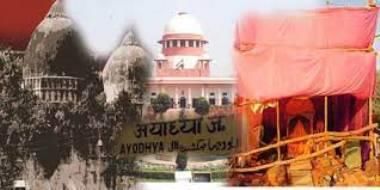
Why in News?
The Places of Worship (Special Provisions) Act, 1991, which aims to safeguard the religious character of places of worship, is currently facing legal challenges. The recent dispute surrounding the Shahi Jama Masjid in Sambhal, Uttar Pradesh, has brought renewed attention to the Act's implications and its applicability in ongoing religious conflicts.
Key Takeaways
- The Shahi Jama Masjid dispute has its roots in claims that the mosque was built over a historical Hindu temple.
- The Places of Worship Act seeks to maintain the religious character of places of worship as it was on August 15, 1947.
- Legal challenges against the Act raise significant questions about communal harmony and judicial review.
Additional Details
- Shahi Jama Masjid Dispute: The mosque, built in the 16th century by Mir Hindu Beg, is claimed by petitioners to be constructed on the site of the ancient Hari Har Mandir. This dispute reflects similar contentions seen in other regions such as Varanasi and Mathura.
- Judiciary Involvement: A Sambhal district court had initiated a survey to ascertain the mosque's historical claims, which unfortunately led to violent protests during a subsequent survey.
- Legal Status: The Shahi Jama Masjid is recognized as a protected monument under the Ancient Monuments Preservation Act, 1904, and is listed by the Archaeological Survey of India as a Monument of National Importance.
- Key Provisions of the Act: The Act includes provisions that prevent changes to the religious identity of places of worship, limit judicial review, and impose penalties for violations.
- The ongoing debates surrounding the Places of Worship Act underscore the complexities of maintaining religious harmony in India. As legal challenges continue, there is a critical need for clear judicial interpretations to navigate these sensitive issues effectively.
SC Prioritising SLPs Disposal
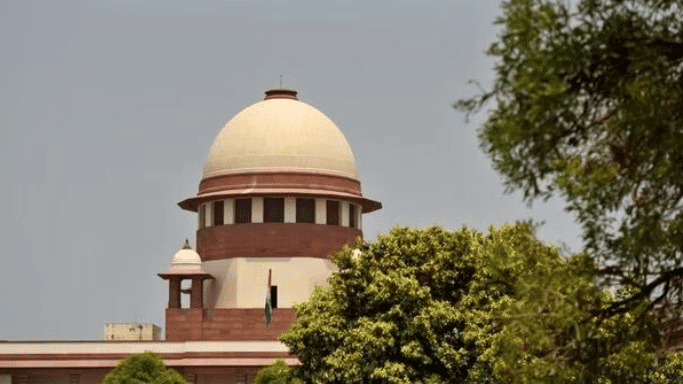
Why in News?
- The Supreme Court (SC) has begun prioritizing the hearing of special leave petitions (SLPs) as part of its efforts to reduce the significant number of cases filed each year, along with a considerable backlog.
- As of December 2024, over 82,000 cases are pending in the SC, prompting the Chief Justice of India (CJI) to implement such strategies.
What is a Special Leave Petition (SLP)?
About:
- An SLP is a mechanism under Article 136 of the Constitution of India that allows the Supreme Court to hear appeals against judgments, decrees, or orders of any court or tribunal, except Armed Forces Tribunals.
- The concept of "special leave" originates from the Government of India Act, 1935, which recognized the prerogative to grant special leave for appeals.
- Key features of SLPs include their extraordinary nature, applicability to both civil and criminal matters, and the discretion of the Supreme Court to grant or deny leave without providing reasons.
- SLPs are typically invoked in cases involving substantial questions of law or a miscarriage of justice.
Eligibility:
- Any aggrieved party can file an SLP against a judgment or order of a High Court or tribunal, especially when a certificate of fitness for appeal to the Supreme Court has been denied, or substantial questions of law or injustice are involved.
Time Limit to File a SLP:
- An SLP can be filed within 90 days from the date of a High Court's judgment.
- If the High Court refuses to grant a certificate of fitness for appeal to the Supreme Court, the SLP must be filed within 60 days from the date of such refusal.
Procedure for Filing a SLP:
- The procedure for filing a SLP involves submitting the petition to the Supreme Court, along with necessary documents and fees.
What are the Supreme Court Cases Related SLPs?
- In Laxmi & Co. v. Anand R. Deshpande (1972), the SC held that during appeals under Article 136, the Court may consider subsequent developments to expedite proceedings, safeguard the rights of parties, and uphold the interests of justice.
- In Kerala State v. Kunhayammed (2000) SC ruled that declining to grant an SLP does not invoke its appellate jurisdiction. This discretion ensures that the SC intervenes only in cases warranting judicial scrutiny.
- In Pritam Singh v. The State (1950), it was emphasized that the SC should exercise its powers under Article 136 sparingly, interfering with High Court decisions only in exceptional cases. Once an appeal is admitted, the appellant may challenge any erroneous legal findings by the High Court.
- In N. Suriyakala v. A. Mohandoss & Ors. (2007) SC clarified that Article 136 does not establish an ordinary appellate forum but grants broad discretionary powers to the Supreme Court to intervene for ensuring justice, rather than providing a right of appeal to litigants. Filing SLPs indiscriminately goes against the purpose of Article 136.
SC Guidelines on Death Penalty and Mercy Petitions
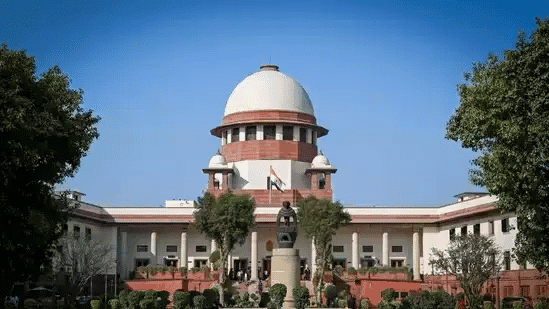
Why in News?
In a recent ruling in the case of State of Maharashtra Vs. Pradeep Yashwant Kokade, the Supreme Court of India established new guidelines aimed at improving the processes related to mercy petitions and the execution of death penalties. The primary goal of these guidelines is to prevent unnecessary delays and safeguard the legal rights of convicts.
Key Guidelines Issued by the Supreme Court
- Dedicated Cells for Mercy Petitions: States and Union Territories (UTs) are mandated to set up dedicated cells specifically for handling mercy petitions. These cells are expected to process petitions promptly and within the stipulated timeframe.
- Attachment of Judicial Officer: A judicial officer from the Law and Judiciary Department should be assigned to the dedicated cell to oversee the processing of mercy petitions.
- Information Sharing and Documentation: Prison authorities are required to forward mercy petitions to the dedicated cell. They should also seek information from police stations and investigation agencies as necessary to facilitate the processing of these petitions.
- Coordination with Governor and President's Secretariats: Mercy petitions should be forwarded to the secretariats of the Governor and the President for further action as part of the processing procedure.
- Electronic Communication: Communications regarding mercy petitions are encouraged to be conducted via email to enhance efficiency, except in cases where confidentiality is required.
- Guidelines and Reporting: State Governments are instructed to issue executive orders outlining the procedures for handling mercy petitions in accordance with the Supreme Court's guidelines.
- Implementation: States and UTs are expected to report their compliance with the Supreme Court's directions within a period of three months.
- Guidelines to Sessions Courts: Sessions Courts should maintain records of cases related to mercy petitions and issue notices to public prosecutors or investigative agencies for any pending appeals.
- Execution Warrants: Execution warrants for death penalties are to be issued by the State immediately after the death penalty becomes enforceable, ensuring a prompt and clear process for execution.
Anna Chakra and SCAN for Reforming PDS System
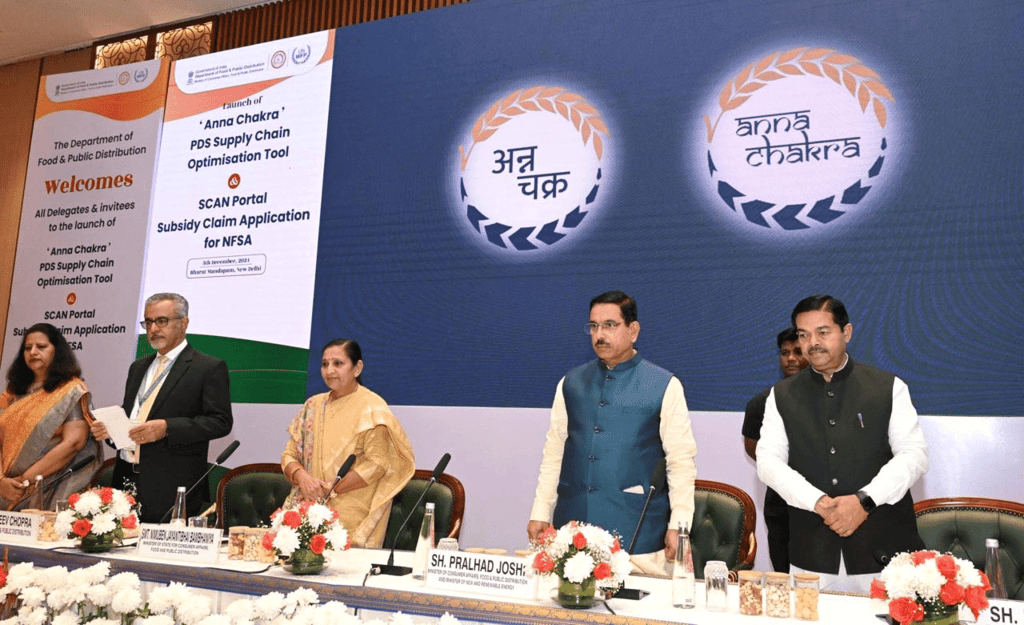
Why in News?
The Union government has recently introduced the Anna Chakra and the Subsidy Claim Application for NFSA (SCAN) portal. These initiatives aim to modernize the Public Distribution System (PDS) and streamline subsidy claim processes.
What is Anna Chakra?
The Anna Chakra is a system designed to optimize the movement of food grains within the Public Distribution System (PDS) in India. Developed by the Department of Food and Public Distribution in collaboration with the World Food Programme (WFP) and IIT Delhi’s Foundation for Innovation and Technology Transfer (FITT), it utilizes advanced algorithms to enhance the efficiency of the food grain supply chain.
Key Features of Anna Chakra
- Route Optimization: The system uses algorithms to determine the most efficient routes for transporting food grains, aiming to reduce both transportation time and costs.
- Integration with Railways and Logistics Platforms: Anna Chakra is integrated with the Freight Operations Information System (FOIS) of the Railways and the PM Gati Shakti platform. This integration helps in mapping the geo-locations of Fair Price Shops (FPSs) and warehouses, facilitating better coordination and efficiency in the supply chain.
- Environmental Benefits: By optimizing transportation routes and reducing the time taken for transport, Anna Chakra contributes to lowering transportation-related emissions. This, in turn, helps in reducing the carbon footprint and promoting sustainable development.
SCAN Portal
The Subsidy Claim Application for NFSA (SCAN) Portal is an initiative aimed at simplifying and expediting the subsidy claim process for states under the National Food Security Act (NFSA).
Key Features of the SCAN Portal
- Single-Window Submission: The portal allows states to submit their subsidy claims through a single window, streamlining the process and making it more efficient.
- Automated Workflow: The SCAN portal employs rule-based automation to handle various stages of the claim process, including scrutiny, approval, and settlement. This automation helps in speeding up the process and reducing the chances of errors.
- Efficiency in Subsidy Settlement: The portal enables real-time monitoring of subsidy claims, which helps in reducing delays in fund disbursal and ensuring that states receive their entitled subsidies in a timely manner.
Other Initiatives for Food Security
Pradhan Mantri Garib Kalyan Anna Yojana (PMGKAY)
- Provides 5 kg of wheat or rice free every month to beneficiaries.
- Initially launched during the COVID-19 pandemic in March 2020.
- Extended for five years from January 2024.
Antyodaya Anna Yojana (AAY)
- Households are entitled to receive 35 kg of grains monthly at subsidized rates.
- Rice: ₹3/kg; Wheat: ₹2/kg, regardless of family size.
Integrated Management of Public Distribution System (IM-PDS)
- Facilitates the One Nation One Ration Card (ONORC) scheme.
- Allows beneficiaries to access food grains across India.
- Improves food security for migrant workers.
Decentralized Procurement (DCP) Scheme
- Encourages states to procure and distribute food grains directly.
- Reduces logistics costs and ensures localized management of food security.
Challenges with the PDS System
- Diversion of Food Grains:. significant portion of food grains is leaked during transportation or diverted to the black market.
- Inclusion and Exclusion Errors: Non-eligible households receive benefits, burdening the system. Genuine beneficiaries are excluded due to flaws in the identification process.
- Corruption at Fair Price Shops (FPS): Issues such as under-weighing food grains, selling poor-quality goods, or charging higher prices undermine the system’s effectiveness.
- Inadequate Warehousing Facilities: Insufficient warehousing leads to spoilage and wastage of food grains.
Way Forward
- Infrastructure Expansion: Strengthen storage and transportation facilities to support the growing scale of food distribution operations.
- Technological Integration: Leverage advancements in artificial intelligence and blockchain technology for real-time tracking of food grains and reducing inefficiencies in the supply chain.
- Sustainable Practices: Promote green logistics and energy-efficient transportation solutions to further reduce the carbon footprint associated with food grain distribution.
Rashtriya Gokul Mission
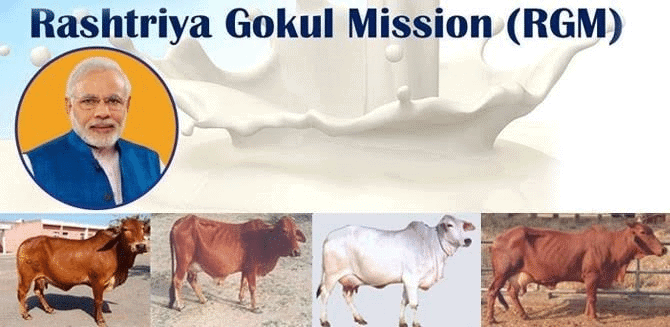
Why in News?
The Rashtriya Gokul Mission (RGM) was launched in December 2014 to promote the development and conservation of indigenous bovine breeds in India. The primary aim of the mission is to increase milk production and the productivity of bovines to meet the growing demand for milk and make dairy farming more profitable for rural farmers.
- With a budget of Rs. 2400 crore allocated for the period from 2021 to 2026, the RGM continues to operate under the Rashtriya Pashudhan Vikas Yojna. The mission is expected to benefit all cattle and buffaloes across India, with a particular focus on small and marginal farmers.
- The RGM is especially beneficial for women farmers, who contribute over 70% of the labor in livestock farming. By improving the productivity of indigenous breeds such as Gir, Sahiwal, Rathi, Deoni, Tharparkar, and Red Sindhi, the mission aims to enhance the genetic profile of these breeds and increase their stock.
Background of Rashtriya Gokul Mission
- The Rashtriya Gokul Mission (RGM) was initially launched as the National Programme for Bovine Breeding and Dairy Development in 2013.
- In 2014, the program was renamed to Rashtriya Gokul Mission to focus on promoting and conserving indigenous bovine breeds.
- Indigenous breeds are local breeds found exclusively in a particular region, state, or country. The scheme aims to increase milk production and bovine productivity to meet the rising milk demand and make the dairy sector more profitable for rural farmers.
- The upgraded scheme was initially launched for the period 2014 to 2017, but it has now been extended from 2021 to 2026 under the Rashtriya Pashudhan Vikas Yojna with a budget outlay of Rs. 2400 crore.
- The RGM aims to enhance the productivity of small and marginal farmers involved in the dairying and livestock sector.
- The scheme also empowers the women workforce, as women perform over 70% of the labor in cattle production.
Objectives of Rashtriya Gokul Mission
- To promote and conserve indigenous breeds of cattle.
- To improve the genetic profile and stock of indigenous cattle through breed development programs.
- To enhance milk production and productivity of indigenous bovine animals.
- To improve the productivity of low-quality cattle by breeding them with premier indigenous breeds.
- To distribute disease-free, high-genetic-worth indigenous bulls for natural breeding services.
- To increase trade related to animal and livestock products in western countries by addressing sanitary and phytosanitary issues.
- To establish an e-marketplace for bovine germplasm to connect breeders and farmers.
- To organize breeding of all breedable female bovines using modern technologies like Artificial Insemination or natural service with high genetic merit germplasm.
Benefits of Rashtriya Gokul Mission
- Increase milk production capacity in the country.
- Develop a culture of livestock rearing alongside agriculture, providing a buffer for farmers during crop failures or poor monsoons.
- Increase per capita availability of milk.
- Reduce disease burden by developing indigenous cattle breeds which are tough, resilient, and suited to local climates and environments.
- Establish dairy infrastructure for proper processing, acquisition, and marketing of dairy products, creating new employment opportunities.
- Promote growth of related industries such as fodder and organic manure.
- Empower women by providing monetary support to those engaged in the dairy sector.
Why is the Rashtriya Gokul Mission needed?
- Utilising Large Cattle Population – With a bovine population of around 300 million, including 191 million cattle and 109 million buffaloes, the RGM aims to effectively utilize this population to enhance farmers’ income and contribute to national growth.
- Declining Indigenous Breeds – India’s genetic resource includes 41 registered indigenous cow breeds and 13 buffalo breeds, some of which are rapidly declining and require immediate conservation efforts.
- Reduce Dependence on Foreign Breeds – Indigenous cattle are robust, resilient, and better suited to local climates, requiring less care compared to foreign breeds.
- Good Quality Milk – Indigenous cattle produce milk with higher fat and SNF (solids not fats) content, contributing to better nutritional value.
- Safeguard Against Climate Change – Indigenous breeds are expected to be less affected by climate change compared to foreign breeds, making them more viable in changing environmental conditions.
Funding for Rashtriya Gokul Mission
- The Rashtriya Gokul Mission is funded on a 100 percent grant-in-aid basis by the Central Government, with certain exceptions.
- The total financial outlay for the scheme is Rs. 2400 Crore.
- The components not covered under the grant-in-aid basis funding include:
- Accelerated breed improvement program
- Promoting sex-sorted semen
- Establishment of breed multiplication farms
Implementing Agencies under Rashtriya Gokul Mission
- Livestock Development Boards. State implementing agencies responsible for overseeing the mission at the state level.
- CFSPTI. Central Frozen Semen Production and Training Institute, Bengaluru, involved in the production and training of frozen semen for artificial insemination.
- CCBFs. Central Cattle Breeding Farms, contributing to the breeding and conservation of indigenous cattle.
- ICAR. Indian Council of Agricultural Research, involved in research and development related to animal husbandry and dairy.
- Universities, Colleges, NGOs. Various educational institutions and non-governmental organizations contributing to the mission through research, training, and implementation.
- Gaushalas. Cow shelters involved in the care and breeding of indigenous cattle.
Initiatives under Rashtriya Gokul Mission
- National Kamdhenu Breeding Centre. Centers established for the nurturing, development, and conservation of indigenous breeds using scientific methods. Currently, there are two centers in Hoshangabad, Madhya Pradesh, and Nellore, Andhra Pradesh.
- “E-Pashu Haat” – Nakul Prajnan Bazaar. An electronic market portal connecting breeders and farmers with services related to quality disease-free bovine germplasm, including semen, embryos, calves, heifers, and adult bovines.
- Pashu Sanjivani. An animal wellness program allocating Animal Health cards with Unique Identification (UID) to monitor and maintain the health of animals.
- Advanced Reproductive Technology. Utilizing assisted reproductive techniques such as In-vitro Fertilization (IVF), Multiple Ovulation Embryo Transfer (MOET), and sex-sorted semen to improve the availability of disease-free female bovines. A nationwide Artificial Insemination (AI) program was launched in 2019 across 600 districts.
- National Bovine Genomic Center. Establishment of a center for breeding highly genetic bulls at a young age for indigenous breeds.
- Gokul Gram. Integrated cattle development centers promoting indigenous cattle rearing, modern farm management practices, and high genetic quality bulls. The total capacity of each Gokul Gram will be about 1000 animals, maintaining a ratio of 60:40 between milch and unproductive animals. The project aims to generate economic resources from the sale of A2 milk, organic manure, vermicomposting, urine distillates, and biogas power generation.
Current Status of Rashtriya Gokul Mission – Accomplishments
- Gopal Ratna awards and Kamdhenu awards are given annually to motivate farmers to rear Indigenous breeds of Bovines. These awards include monetary incentives and trophies.
- Free Artificial Insemination services are provided at farmers’ doorstep, benefiting 2.28 crore farmers with 4.33 crore Artificial Insemination performed.
- 19 operational bovine IVF/ ETT labs across the country for advanced breeding techniques.
- Multi-purpose Artificial Insemination Technicians in Rural Areas (MAITRIs) have been inducted to deliver breeding inputs at farmers’ doorstep, achieving 90% accuracy in Sex sorted semen production for female calves.
Challenges of the Rashtriya Gokul Mission
- According to the livestock census, the number of indigenous cattle breeds has declined by 9% while the number of foreign exotic breeds has increased by 20%.
- The establishment of Gokul Grams requires over 209 hectares (ha) of land and about 1000 cattle, which is challenging with the current funding allocated by the center.
- The dairy sector faces issues such as lack of expertise and quality services to farmers, inadequate infrastructure, and shortage of fodder in Gokul Grams.
- Outbreaks of diseases such as Lumpy Skin disease among cattle pose significant challenges.
One Rank One Pension (OROP)
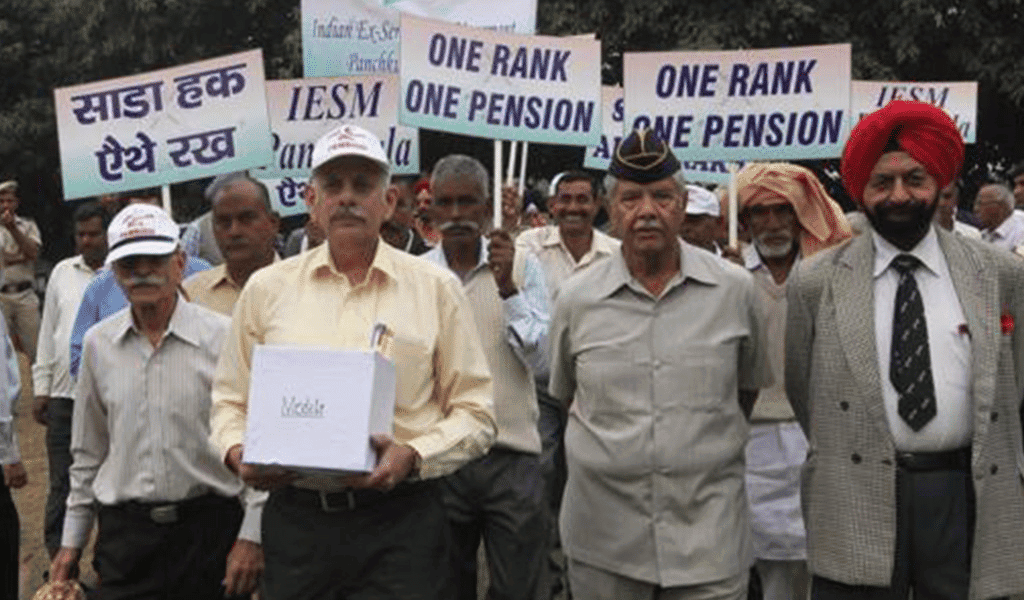
Why is it News?
- Recently, the Prime Minister celebrated the implementation of the One Rank One Pension (OROP) scheme, which was officially put into effect on November 7, 2015, with benefits retroactively starting from July 1, 2014.
- OROP aims to ensure that armed forces personnel receive uniform pension benefits based on their rank and length of service, demonstrating the government's commitment to supporting veterans and their families.
What is OROP?
Background: The concept of 'One Rank One Pension' has evolved through various recommendations and reports over the years:
- K.P. Singh Dev Committee (1984): Suggested addressing 'One Rank One Pension' based on pension principles for judges.
- 4th Central Pay Commission: Found it challenging to equalize pensions without extensive administrative efforts.
- 5th Central Pay Commission: Opposed 'One Rank One Pension' due to changing job roles and qualifications.
- Cabinet Secretary Committee (2009): Rejected 'One Rank One Pension' but recommended measures to reduce pension disparity.
- Rajya Sabha Petition Committee: Recommended implementing 'One Rank One Pension' for all Defence Forces personnel.
Key Features of OROP:
- Pension Determination: Pensions are based on rank and length of service, ensuring fairness among retirees while protecting those already receiving above-average amounts.
- Pension Revision: Pensions are re-fixed every five years to reflect changes in salaries and pensions of serving personnel, with the first revision having taken place on July 1, 2019.
- Financial Implications: The estimated annual cost for implementing OROP revisions is around Rs 8,450 crore.
- Beneficiaries: Over 25.13 lakh armed forces pensioners and their families are expected to benefit from this scheme, including provisions for family pensioners, war widows, and disabled pensioners.
- Regional Distribution: Uttar Pradesh and Punjab have the highest number of OROP beneficiaries.
Supreme Court Ruling on OROP:
- In the case of Indian Ex-Servicemen Movement v Union of India, the Supreme Court upheld the constitutional validity of the OROP scheme.
- Pension Differences: The Court clarified that variations in pensions for personnel of the same rank based on their retirement dates are not arbitrary.
- Factors Influencing Pensions: Differences in pensions are attributed to factors such as Modified Assured Career Progression (MACP) and variations in base salary calculations.
Socio-Economic Implications of OROP:
- Welfare Enhancement: OROP significantly boosts the financial security of veterans and their families, enhancing their overall well-being.
- Economic Impact: Increased pensions contribute to higher disposable incomes for veterans, potentially stimulating local economies through increased spending.
- Social Recognition: The implementation of OROP publicly acknowledges the sacrifices made by armed forces personnel, fostering a sense of pride and respect within society.
- Uniform Pension: Ensures equal pensions for personnel retiring in the same rank with the same length of service, irrespective of retirement date.
- Pension Revision: Pension is re-fixed every five years to keep up with current standards.
Issues in Implementation of the OROP Scheme:
- High Cost: The implementation cost is significantly higher than initially estimated, impacting the exchequer. For instance, the cost was initially estimated at Rs. 500 crore, but the actual cost ranges between Rs. 8000-10000 crore.
- Administrative Challenges: There are difficulties in retrieving and verifying past records for eligible personnel, such as accessing historical service records to provide accurate benefits.
- Complex Implementation: The scheme faces administrative, financial, and legal complications in executing effectively, including legal and logistical issues in ensuring seamless delivery of pension benefits to all eligible individuals.
Pardoning Powers of President in India
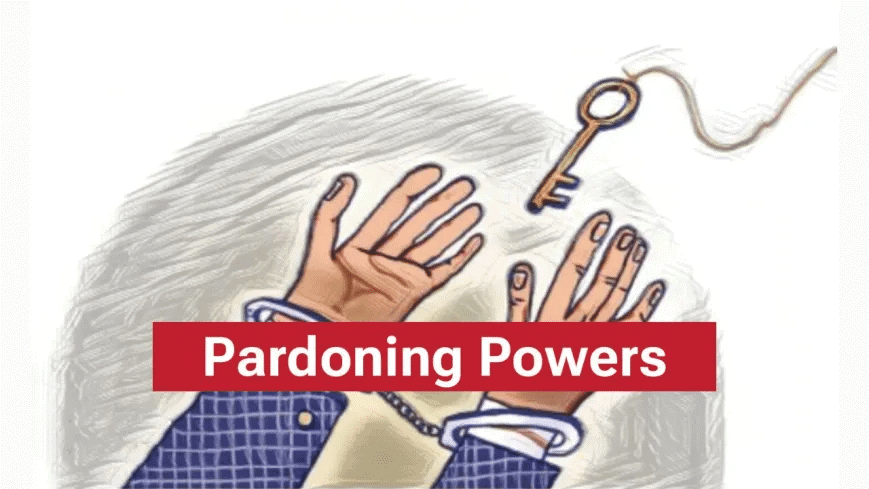
- The President's pardoning power in India, rooted in principles of grace and public welfare, enables the mitigation of sentences in cases of judicial error, excessively harsh punishment, or for compassionate reasons.
- Under Article 72 of the Constitution, this power extends to court-martial cases, violations of Union laws, and death penalties, while differing from the Governor's authority under Article 161.
- Acting on the advice of the Cabinet, the President's clemency decisions are generally not subject to judicial review unless exercised arbitrarily. Landmark cases like Maru Ram (1981) and Shatrughan Chauhan (2014) have clarified the scope of this power, emphasizing the need for timely and just decisions, particularly in death row cases, to prevent prolonged mental distress for convicts.
What is Pardoning Power?
The power of pardon, rooted in principles of grace and humanity, serves as a means to balance justice with mercy, fostering political morality and public good by offering relief in cases of judicial error or questionable convictions.
- In India, this power is vested in the President and Governors under Articles 72 and 161 of the Constitution.
- Globally, pardoning practices have evolved from British royal prerogatives and ancient codes to executive powers in modern democracies, such as the U.S. President’s federal pardon authority and similar powers in the U.K. and Canada.
- Although pardons can correct judicial imperfections, they remain controversial due to potential misuse, prompting many countries to adopt judicial reviews to prevent undue influence and safeguard the integrity of clemency decisions.
Pardoning Powers of the President
The President of India possesses the authority to grant clemency under Article 72 of the Constitution. This power is distinct from the judiciary and is not intended as a mechanism for appealing court decisions. The President's pardoning power serves two primary purposes:
- To rectify possible judicial errors.
- To offer relief from disproportionately severe sentences.
The President's pardoning power encompasses several forms of clemency:
- Pardon:. pardon completely nullifies the conviction and sentence, freeing the convict from all legal penalties, punishments, and disqualifications related to the offence. It is the most comprehensive form of clemency, as it fully restores the individual's legal status and rights.
- Commutation: Commutation substitutes a harsher punishment with a lighter one. For instance, a death sentence may be commuted to life imprisonment, which could further be reduced to rigorous or simple imprisonment. Unlike a pardon, commutation does not erase the conviction but alters the punishment to a less severe form.
- Remission: Remission shortens the duration of a sentence while preserving its original character. It reduces the sentence's length but does not change the nature of the punishment or absolve the convict of guilt.
- Respite:. respite awards a lesser sentence than initially imposed, usually due to exceptional circumstances, such as the convict's health or pregnancy. It temporarily or permanently mitigates the severity of the sentence.
- Reprieve:. reprieve is a temporary halt of a sentence, particularly a death sentence, providing the convict time to seek a pardon or commutation. It is generally granted to facilitate further appeals or applications for clemency
Pardoning Powers of the President: Principles
The President's pardoning powers, as per Article 72 of the Constitution, are subject to key principles established by the Supreme Court. These principles outline the scope, application, and limitations of this power.
- No Entitlement to Oral Hearing: Mercy petitioners are not entitled to an oral hearing with the President.
- Re-evaluation of Evidence: The President can re-assess the evidence and may reach a different conclusion from the courts.
- Cabinet Advice: This power is exercised by the President based on the advice of the Union Cabinet.
- No Obligation to Provide Reasons: The President is not required to give reasons for his decision.
- Grounds for Relief: Relief can be granted for excessively harsh sentences and clear mistakes.
- No Specific Guidelines: The Supreme Court does not need to prescribe specific guidelines for using this power.
- Judicial Review: Judicial review of the President's decision is limited to cases of arbitrariness, irrationality, bad faith, or discrimination.
- Filing Another Petition: Filing another mercy petition after a rejection does not warrant a stay.
Pardoning Powers of the President: Constitutional Provisions
Article 72 of the Indian Constitution empowers the President to grant pardons, reprieves, respites, or remissions of punishment, as well as to suspend, remit, or commute sentences in specific cases. This authority applies in three situations: when the punishment or sentence results from a court-martial, when the offence violates laws under the Union's executive power, and when the sentence involves the death penalty.
- Pardoning Power in Court Martial Cases: The President's authority includes intervening in sentences imposed by court-martials, reflecting the role of the supreme commander of the armed forces. This power ensures that military justice can be tempered with mercy, providing a crucial check within military tribunals.
- Pardoning Power over Union Laws: Article 72 extends the President’s power to offences under Union laws, underscoring the federal structure of governance. It ensures consistency in applying justice for offences impacting national interest or requiring uniformity across states, preserving coherence in executive actions.
- Pardoning Power in Death Sentence Cases: One of the most significant aspects of Article 72 is the President's power to grant pardon in death sentence cases. This provision reflects the Constitution's commitment to humanitarian values, allowing for review and potential mitigation of capital punishment.
- Limitations on Presidential Pardoning Power: Article 72 does not override other authorities. Union officers maintain their powers over court-martial sentences, and state executives can intervene in death sentence cases. This ensures a balance of power across branches of government.
- Procedure and Accountability: The President exercises pardoning power on the advice of the Home Minister, underscoring executive accountability. This procedural requirement ensures decisions regarding pardoning power are made with due deliberation and within the framework of government consultation.
Pardoning Powers of the President Key Judgments
The pardoning powers of the President of India, as outlined in Article 72 of the Constitution, have been subject to various landmark judgments by the Supreme Court. These rulings have clarified the scope, limitations, and procedural aspects of exercising this power. Below are some significant cases that have shaped the understanding of presidential pardoning powers:
- Maru Ram v. Union of India (1981): In this case, the Supreme Court emphasized that the power to grant pardons must not be exercised arbitrarily and should adhere to a sensible approach. The Court ruled that public power should not be misused and must be exercised in a manner that is just and reasonable. This judgment highlighted the need for a balanced exercise of discretion in granting a Pardon.
- Kehar Singh v. Union of India (1989): This case involved Kehar Singh, who was convicted for the assassination of Prime Minister Indira Gandhi. The Supreme Court held that the President has the authority to independently scrutinise evidence and arrive at a different conclusion regarding guilt and sentence when considering a pardon. The ruling underscored that while the President formally holds this power, it is exercised based on the advice of the Council of Ministers, typically led by the Home Minister.
- Dhananjoy Chatterjee v. State of West Bengal (1994): In this landmark ruling, the Supreme Court reiterated that the President must act on the advice of the Council of Ministers while deciding on mercy pleas. The Court clarified that although the President has significant powers under Article 72, these powers are not absolute and must be exercised by constitutional provisions and established procedures.
- Shatrughan Chauhan v. Union of India (2014): This judgment addressed issues related to delays in executing death sentences and highlighted that such delays could lead to mental agony for convicts on death row. The Supreme Court emphasized that mercy petitions should be decided expeditiously. It noted that prolonged delays could amount to a violation of Article 21 (Right to Life) of the Constitution.
- Pawan Gupta v. Union of India (2020): In this case concerning one of the convicts in the Nirbhaya gang rape case, the Supreme Court ruled that there is no inherent right to seek a pardon or commutation, but if a mercy petition is filed, it must be considered fairly and justly by the President.
|
142 videos|779 docs|202 tests
|

















